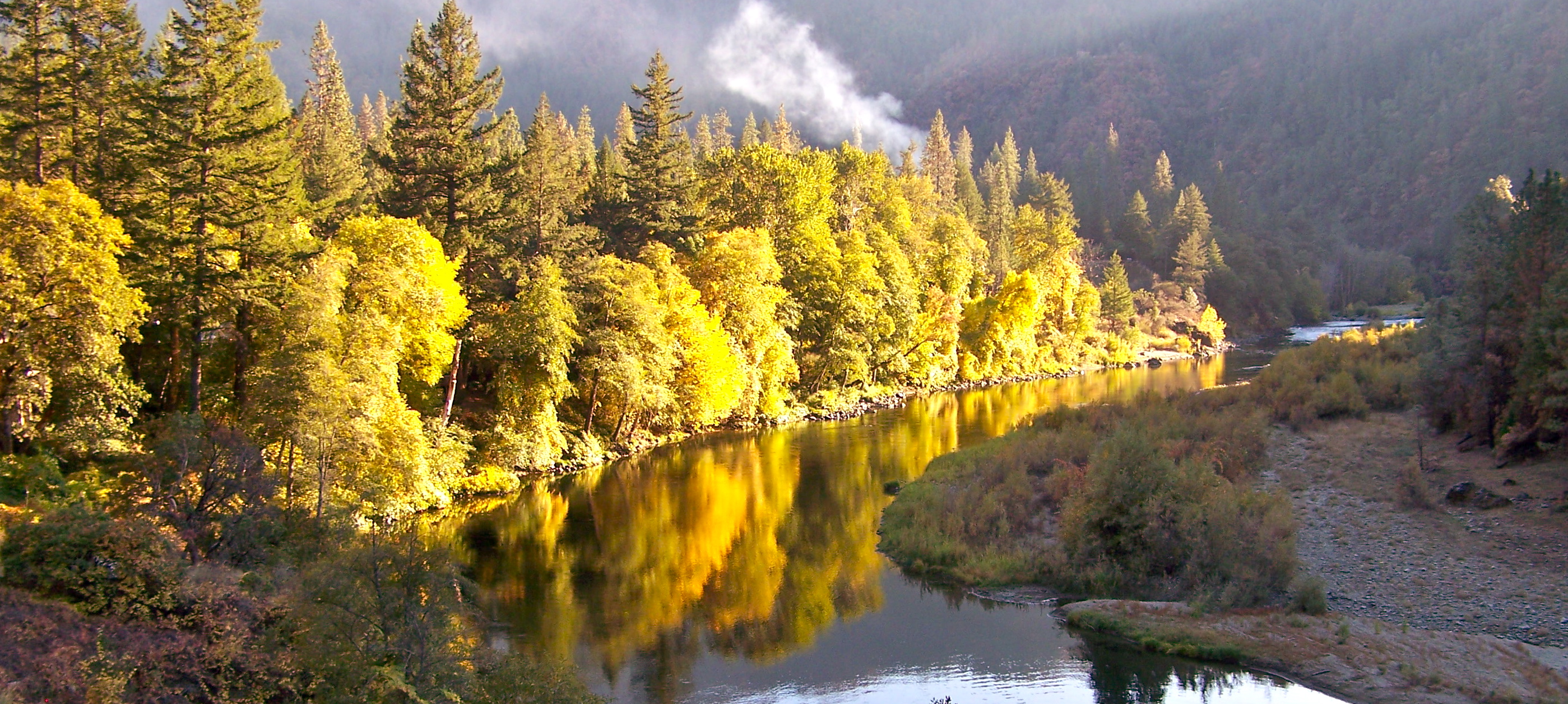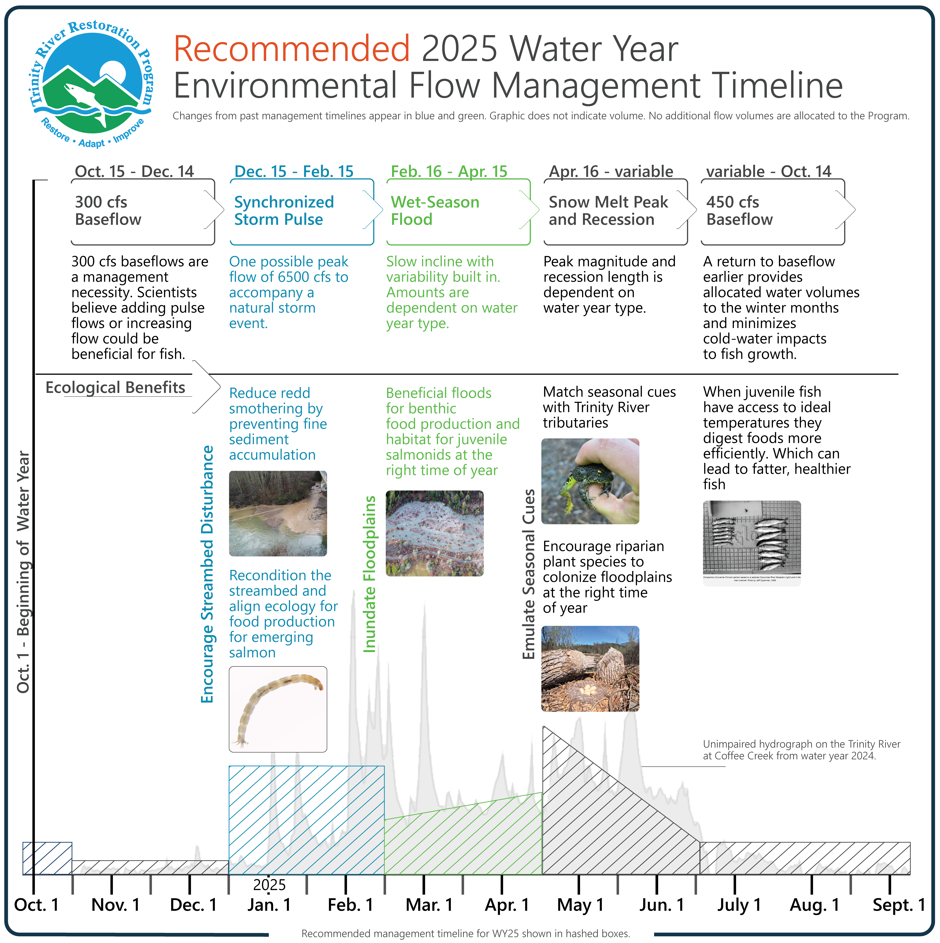Rivers are vital parts of our ecosystems, and they behave differently depending on the climate they flow through. In a Mediterranean climate, which is characterized by hot, dry summers and variable, wet winters, river flow can be particularly interesting. Let’s explore some important terms and concepts related to river flow that is represented in our unique climate and system.

What is River Flow?
At its most basic, river flow, or discharge, is the volume of water that moves through a river over a specific period of time. On the Trinity River, flow is typically measured in cubic feet per second (CFS). Currently flow rates are measured in a few locations above and below Trinity and Lewiston Dams. Discharge on the Trinity River at Lewiston has been measured daily since 1911, when Model T’s were just rolling off of the assembly line!
There are very few rivers in California that experience full natural flow. Most Northern California rivers are managed through dams that generate power, create water diversions, or hold back water for later use. Dams block upstream deposits of water, wood and sediment and when managed narrowly have caused significant harm to riverine ecology downstream.
Understanding river flow both pre-dam and post-dam helps river ecologists to compare current management with the pre-dam natural conditions that species and their ecology developed within. This strategy aims to deepen understanding of the natural environment to provide favorable conditions for plants, wildlife, and people that depend on the river.
Why is River Flow Important?
The Trinity River’s flow is crucial for many reasons:
- Ecosystems: Flow influences the types of plants and animals that live in and around the river.
- Water Supply: The Trinity River provides drinking water, supports economic development, supplies irrigation for agriculture and generates power for millions of Californians.
- Recreation: The Trinity River supports activities like fishing, boating, hiking, gold panning, wildlife viewing and swimming.
Key Terms Related to River Flow: Managed vs Natural
Natural Seasonal Flow: Although highly variable from year to year, undammed rivers in a Mediterranean climate, tend to exhibit seasonal patterns. During the rainy winter months, flow rates typically increase due to precipitation, the size and magnitude of that increase depends on seasonal patterns and the frequency of storm events. In the spring, snow in the mountains melts adding flow to the Trinity River and its watershed. Conversely, in summer, flow rates tend to slowly decrease as the dry season progresses.
Natural Base Flow: This is the normal level of water flow in a river during dry periods. It usually comes from groundwater and keeps the river flowing even when there hasn’t been rain for a while. In a Mediterranean climate, base flow can be low during the summer months due less water in the system and high evaporation rates. Baseflows are important for cold-blooded aquatic species like foothill yellow legged frogs who utilize slow water for rearing and then populate riverside riparian areas as adults.
Hydrograph: A graph that illustrates how the flow of water in a river changes over time. It shows time on the horizontal axis and the flow rate, usually measured in cubic feet per second, on the vertical axis. As the line on the graph rises, it indicates an increase in river flow (like after rain), and when it falls, it represents a decrease (such as during dry periods). Hydrographs are important for managing water resources, studying weather patterns as well and ensuring that environmental flow needs are met in regulated river systems.
Natural Surface Runoff: After it rains, water flows over the land and enters rivers. This is known as surface runoff. Winter rains in the Trinity watershed typically lead the tributaries and the Trinity River (below Douglas City) to a spike in flow. However, the impact is highly dependent on the water year, ground saturation and snow accumulation. Surface runoff provides additional wood, leaf litter and sediment to rivers which are the building blocks for healthy habitat creation in the Trinity system.
Over-bank floods: When there is a lot of rain in a short period, rivers can overflow their banks, causing over-bank floods. On the Trinity River over-bank floods are more likely to occur during the wet season and provide important ecological functions, including to Trinity River fish. These flows improve soil quality, provide prime growing grounds for aquatic insects and other fish food and help to reset the form of the river’s main channel through scour.
Environmental Flow: Is a management term that identifies the quantity and timing of water needed to sustain the health of river ecosystems, particularly downstream from a dam. Managing environmental flow is important for maintaining habitat for Trinity River salmonids and other wildlife that depend on the river. Within the environmental flows framework there are many methods for implementation. Since 2004, the Trinity River Restoration Program’s method for environmental flows were based on functional implementation of three periods, a summer baseflow (450 CFS), a fall/winter baseflow (300 CFS), and a spring snowmelt mimic hydrograph. Since 2016 local scientists have advocated to adapt this method by adding variable flows to the wet-season months (December – April) for the benefit of growing healthier juvenile salmonids.
Recommended Periods within the Environmental Flow Timeline for Water Year 2025

1. December 15 – February 15 – Synchronized Storm Pulse
A dam release synchronized to a natural storm event. The release is triggered by a CNRFC forecast for the Trinity River above North Fork that rises to 4500 CFS or more. Once initiated, the release would be triggered even if the forecast is reduced. The primary purpose is to reduce redd smothering by preventing fine sediment accumulation from tributaries, to maximize the synchrony between tributaries and the mainstem of the river, as well as recondition the streambed and align the ecology for salmon food production.
2. February 16 – April 15 – Wet Season Flood
Depending on forecast water year type in the California Department of Water Resources February B120 forecast and whether a synchronized flow has occurred, the Program may schedule flows above baseflow in the Feb. 15 to Apr. 15 timeframe. Depending on the March B120 forecast, the schedule may be adjusted as of March 15. The primary purpose of this is to inundate floodplains for aquatic food production and habitat for juvenile salmonids at the right time of year – similar to natural wet season flooding.
3. April 16 – Variable – Snowmelt Peak and Recession
The spring snowmelt peak and recession are an important annual migratory cue for both adult and juvenile chinook. The Program has implemented a spring snow-melt mimic release annually since 2004. CDWR April B120 forecast determines total volume of restoration flow releases. Water that has not been released for Storm Pulse Flows or Wet Season Flooding is scheduled for release during the Snowmelt Peak and Recession period. This schedule encompasses many purposes for river ecology and the salmonid life cycle.
4. Managed Base Flow
Baseflows released from Lewiston Dam to the Trinity River are currently managed at 450 CFS through the summer, shifting to 300 CFS on Oct 15 through the subsequent spring. This management strategy is a relic from the 1999 Flow Study and was put in place with the mindset that increasing baseflow in the summertime could help with river temperature management for migrating adult spring chinook. Flows reduce in the fall because temperature objectives are no longer needed. In addition, water managers leaned on water savings during the fall through the wet season so that accumulation in the system could be understood prior to use for diversions or river ecology. Fish biologists hypothesize that if current summer and fall management were adapted to a more natural hydrograph it may serve Trinity River salmonids and other wildlife better.
